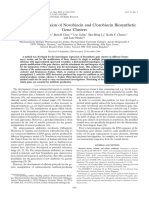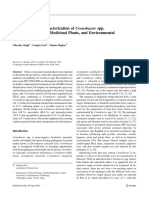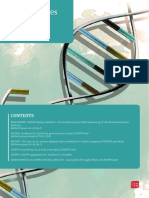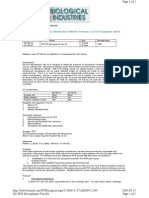B Lactam Chip
B Lactam Chip
Uploaded by
Bd HanCopyright:
Available Formats
B Lactam Chip
B Lactam Chip
Uploaded by
Bd HanOriginal Title
Copyright
Available Formats
Share this document
Did you find this document useful?
Is this content inappropriate?
Copyright:
Available Formats
B Lactam Chip
B Lactam Chip
Uploaded by
Bd HanCopyright:
Available Formats
Mol. Cells, Vol. 14, No. 2, pp.
192-197
M olecules and Cells
KSMCB 2002
Development of DNA Chip for the Simultaneous Detection of Various -Lactam Antibiotic-resistant Genes
Yeonhee Lee1,, Choong-Sik Lee, Yeo-Jung Kim, Sungmin Chun2, Seohyung Park1, Young Sun Kim, and Byoung-Don Han2,*
DisGene, Incorporated, Limited, Yongin 449-916, Korea; 1 Department of Biotechnology, Seoul Womens University, Seoul 139-774, Korea; 2 BMS Korea Research Center, Yongin 449-916, Korea. (Received March 30, 2002; Accepted June 7, 2002)
A robust and fast DNA chip method was developed in order to detect the various -lactam antibiotic-resistance genes in one slide. These genes included PSE, OXA, FOX, MEN, CMY, TEM, SHV, OXY, and AmpC. -lactam antibiotic-resistance genes were labeled with a fluorescent nucleotide by a multiplex polymerase chain reaction using a mixture of specific primer sets for each gene. This labeled target was hybridized with a DNA chip that contained the spots of the specific probe DNAs for each -lactam antibiotic-resistance gene. This technique made it possible to detect the specific resistance gene, even in a single bacterium. Keywords: -Lactam; Antibiotic-resistant; DNA Chip.
Introduction
Since the first appearance of the penicillin resistant bacteria in the 1960s, the number of antibiotic-resistant bacteria keeps increasing as various antibiotics are developed and used (Lee, 1993). The pathogenic bacteria, like all other microorganisms, acquire the resistance by mutation or receiving the resistance gene from other microorganisms for self-defense. The antibiotics that are used in agricultural and fishery products also promote the spread of antibi- otic-resistant bacteria. The misuse and abuse of antibiotics are other factors in increasing the number of antibiotic-resistant bacteria. Currently, several methods such as the Bauer-Kirby test,
minimal-inhibitory concentration (MIC), minimal bactericidal concentration (MBC), Serum-killing power, or polymerase chain reaction (PCR) are being used for the detection of antibiotic-resistant bacteria (Lee, 1993). However, these are somewhat tedious and require a long time span for detection. They also are limited in their assay volume and time. Therefore, it is necessary to develop a simple and rapid method that can accurately, and within a short time span, detect the antibiotic-resistant bacteria in many samples (Bergeron, 2000; Bergeron and Ouellette, 1998). In the present study, we developed a method for the detection of -lactam antibiotic-resistant bacteria by using a DNA chip that is usually used for a gene expression assay (Kim and Kim, 2000). On the DNA chip, the specific probe DNAs that contained the -lactam antibioticresistant genes were spotted. The antibiotic-resistant gene of bacteria was labeled by a multiplex PCR reaction with a mixture of primer sets that were designed to amplify the specific -lactam antibiotic-resistant genes. This method was able to detect the -lactam antibiotic-resistant gene, even in a single bacterium, as well as to detect many resistant genes on one slide.
Materials and Methods
Susceptibility testing Isolates that are resistant to -lactamwere selected, based on MICs that were determined by the agar dilution method. This method is described in the guidelines of the National Committee for Clinical Laboratory Standards Abbreviations: CFU, colony-forming unit; DDST, double-disk synergy test; ESBL, extended-spectrum -lactamase; MBC, minimal-bactericidal concentration; MH, Mueller-Hinton; MIC, minimal-inhibitory concentration; PCR, polymerase chain reaction; S/B, signal to background.
The first two authors contributed equally to this work.
Demo
* To whom correspondence should be addressed. Tel: 82-31-288-6050; Fax: 82-31-288-6069 E-mail: byoungdon-han@bmskorea.co.kr
Yeonhee Lee et al. (NCCLS, 2000). Antibiotics were purchased from the Sigma Chemical Company (USA). The test isolates were inoculated on Mueller-Hinton (MH, Difco, USA) agar plates that contained 104 CFU per spot with a multiple inoculator and incubated at 37C for 18 h. Double-disk synergy test The resistant isolates were screened for the presence of extended-spectrum -lactamases (ESBLs) by Double-disk synergy tests (DDSTs) (Jarlier et al., 1988; Tzelepi et al., 2000). Test strains were preincubated in a MH broth at 37C to an optical density that was equal to that of a 0.5 McFarland turbidity standard. This suspension was then used to inoculate on MH agar plates by swabbing them with a cotton swab. The disks that contained carbenicillin (100 g), aztreonam (30 g), cephalothin (30 g), ampicillin (10 g), cefoxitin (30 g), ceftazidime (30 g), as well as oxacillin (1 g) and lactam-inhibitor combinations that contained the inhibitors clavulanic acid (10 g), sulbactam (10 g), and tazobactam (10 g) were placed on MH agar plates. -lactamases of each of the test isolates were classified by the Bush-Jacoby-Medeiros Group (Bradford, 2001). PCR to detect -lactamase producing genes Each of the lactamase producing genes were amplified with a primer set that was specific to each gene (Table 1), following the conditions that are described in Table 2. Each PCR constituted 30 cycles of denaturation, hybridization, and elongation. Preparation of DNA chip The probe DNAs that were spotted on a chip were prepared by PCR with the primer sets (Table 1) that are specific to each antibiotic-resistant gene. The 5-ends of primers were modified with the (CH2)6 linker and primary amine group. The amplified probe DNAs in the spotting buffer (350 mM sodium bicarbonate, pH 9.0) at 1 M concentration were spotted on a glass slide that was coated with the aldehyde group (CEL Associates, USA) by MicroGrid II (BioRobotics, UK). The amine group on DNAs was coupled with the aldehyde group on a slide by the Schiffs base reaction. NaBH4 reduced the remaining aldehyde groups. The antibiotic-resistant genes on the chip were PSE, OXA, FOX, MEN, CMY, TEM, SHV, OXY, and AmpC. This DNA chip also contained the yeast DNA fragment S400 as a positive control, which was confirmed not to be cross-hybridized with the bacterial genes. Preparation of target DNA To prepare the target DNA from the bacterial cells, the plasmid DNA from the antibioticresistant bacteria, or bacterial cells in 10 l H2O that were disrupted by boiling for 90 s in a microwave oven, were added in 50 l multiplex PCR reaction mixtures. These mixtures contained 5 l 10 PCR reaction buffer (Biotools, Spain), 20 primer mixtures that contained 0.5 mol/L of each primer, 100 mol/L of each dATP, dGTP, and dTTP, 20 mol/L of dCTP, 4 mol/L of Cy5-dCTP (Amersham, USA), and 1 U of Taq DNA polymerase (Biotools, Spain). Amplification was carried out with the following program: an initial denaturing step of 95C for 10 min
193
Table 1. The sequence of primers for each antibiotic resistant gene. Antibiotic resistant gene TEM SHV MEN CMY OXY FOX PSE OXA AmpC Primer sequence 5-ata aaa ttc ttg aag acg aaa-3 5-gac agt tac caa tgc tta atc-3 5-tgg tta tgc gtt ata ttc gcc-3 5-ggt tag cgt tcg cag tgc-3 5-tcc tct ctt cca ga-3 5-cag cgc ttt tcg cgt cta ag-3 5-atg caa caa cga caa tcc atc-3 5-gtt ggg tag ttg cga ttg g-3 5-cag atc tcg aga agc gtt ca-3 5-acc tct ttg cgg ttt ttc gc-3 5-cac cac gag aat aac cat-3 5-atg tgg acg cct tga act-3 5-aat ggc att cag cgc ttc cc-3 5-ggg gct tga tgc tca ctc c-3 5-tca act ttc aag atc gca-3 5-gtg tgt tta gaa tgg tga-3 5-cta cgg tct ggc tgc ta-3 5-gtt ggg gta gtt gcg att gg-3
followed by 35 cycles of 95C for 30 s, 50C for 30 s, and 72C for 40 s, and a final extension at 72C for 10 min. The positive control DNA was labeled with the same procedure as the target DNA, except 200 ng of the plasmid that contained the yeast DNA fragment S400 was added instead of the disrupted bacterial cells. The 45 l target DNA and 1 l positive control were mixed and dried in SpeedVac, then suspended in a 30 l hybridization solution. Hybridization A DNA chip was prehybridized with 15 l of the hybridization solution [5 SSC (8.77 g/L NaCl, 4.41 g/L sodium citrate, pH 7.0], 0.2% SDS, 1 mg/ml herring sperm DNA) and covered with a cover slip (22 mm 22 mm) for 1 h at 65C. After the prehybridization, the solution was changed to the hybridization solution that contained the target DNAs that was denatured at 90C for 5 min, and then hybridized for 2 h at 70C. The DNA chip was washed four times with 2 SSC, 0.1% SDS solution for 5 min each, with 0.2 SSC solution for 5 min twice, and with 0.1 SSC once for 5 min at room temperature. The chip was scanned by the microarray reader ScanArray 5000 (Packard, USA) and analyzed by the software QuantArray (Packard, USA).
Results and Discussion
In the present study, we developed the -lactam antibiotics-resistant bacteria detection DNA chip that is able to screen various -lactam antibiotic-resistant genes in one reaction. DNA probes were prepared with -lactamase producing isolates. At first, these isolates were selected
194
DNA Chip for -Lactam Antibiotic-Resistant Genes
Table 2. PCR condition to detect each gene. Gene TEM SHV MEN CMY OXY FOX PSE OXA AmpC PCR condition 1 min at 95C, 1 min at 46C, 1 min at 72C 1 min at 95C, 1 min at 54C, 1 min at 72C 1 min at 95C, 1 min at 46C, 1 min at 72C 1 min at 95C, 1 min at 54C, 1 min at 72C 1 min at 95C, 1 min at 56C, 1 min at 72C 1 min at 95C, 1 min at 45C, 1 min at 72C 1 min at 95C, 1 min at 46C, 1 min at 72C 1 min at 95C, 1 min at 49C, 1 min at 72C 1 min at 95C, 1 min at 56C, 1 min at 72C Reference Pai et al. (1999) Pai et al. (1999) Gniadkowski et al. (1998) Pai et al. (1999) Fournier et al. (1996) Bauernfeind et al. (1997) Llanes et al. (1999) Speldooren et al. (1998) Nelson and Elisha (1999)
Table 3. MICs9 of -lactamase producing isolates used for producing DNA probe and efficiency test. CCARM10 No. 1134 1136 1155 1173 10071 10075 10076
1 10
Species E. coli E. coli E. coli E. coli K. pneumoniae K. pneumoniae K. pneumoniae
-lactamase PSE FOX, AmpC CMY TEM MEN SHV OXA
GM1 0.5 128 8 > 128 > 128 8 8
NOR2 < 0.25 32 > 128 > 128 8 1 >128
AMP3 64 > 128 > 128 > 128 > 128 > 128 > 128
CEPH4 4 32 > 128 > 128 > 128 > 128 > 128
CEFO5 CEFTA6 CEFTRI7 CEFOX8 < 0.25 < 0.25 64 64 64 32 64 < 0.25 < 0.25 128 32 128 >128 128 < 0.25 < 0.25 64 64 128 32 64 2 8 > 128 8 > 128 2 > 128
, Gentamycin; 2, Norfloxacin; 3, Ampicillin; 4, Cephalothin; 5, Cefotaxime; 6, Ceftazidime; 7, Ceftriaxone; 8, Cefoxitin; 9, MIC unit, g/l; , Culture collection of antibiotic resistant microbes.
with conventional MICs by the agar dilution method (Table 3). Then DDST was performed to select the lactamase producing ones (Table 4). Each -lactamase gene was confirmed with electrophoresis after PCR, and used as a DNA probe on the chip. The advantage of the DNA chip detection system over the multiplex PCR and gel electrophoresis lies in the discrimination of the false positive. The estimated size difference of the PCR amplified products in our multiplex system was too small to identify the individual -lactamase genes (TEM: 1.1 kb, FOX: 1.1 kb, CMY: 1.0 kb). Even though we can select various primer sets to achieve the size difference, there is still a limitation in the number of antibiotics-resistant genes in the multiplex assay. In addition, the hybridization step will greatly decrease the false-positive rate in the DNA chip system. The ten probe DNAs (including the positive controls) were spotted on a glass slide that was coated with the aldehyde groups. The nine -lactamase genes are as follows: PSE, OXA, FOX, MEN, CMY, TEM, SHV, OXY, and AmpC. The positive control is the yeast DNA fragment S400. The target DNAs were labeled by multiplex PCR using bacterial cells that were isolated and characterized (Table 3), as described in Materials and Methods, with Cy5-dCTP and the mixture of primer sets in Table 1, as described in Materials and Methods. The positive control DNA was also labeled by PCR with Cy5-
dCTP using the plasmid that contained the yeast DNA fragment S400. The labeled target DNAs and positive control DNA were mixed and hybridized to the DNA chip. After hybridization, the chip was scanned by the microarray reader ScanArray 5000 (Packard, USA). The result was analyzed by the software QuantArray (Packard, USA). In order to determine the minimal number of bacteria for the detection of antibiotic-resistant genes (sensitivity), the bacterial culture was diluted serially to 103, 102, 10, or 1 cell per PCR reaction. When the labeled products that were amplified from these cells were hybridized, the antibiotic-resistant gene OXY was specifically detected, even from a single bacterium (Fig. 1). In Fig. 2, the signal intensities of the OXY gene spot in the DNA chip were plotted against the number of bacteria. Five replicate experiments were performed to see the reproducibility. The signal intensity increased along with the bacterial number; this was reproducible with the standard deviation of 15% in average signal intensity value. Table 5 shows the mean values of various signal intensities at various numbers of bacteria. The signal to background (S/B) ratio were also in creased as more bacteria were used. The minimal S/B ratio in this experiment is much higher than that of generally accepted microarray data analysis (S/B ratio > 2.5). These results indicate that the antibiotic-resistant detec-
Yeonhee Lee et al. Table 4. Double disk synergy test of -lactamase producing isolates used for producing DNA probe. CCARM No. control clavulanate sulbactam tazobactam control clavulanate sulbactam tazobactam control clavulanate sulbactam tazobactam control clavulanate sulbactam tazobactam control clavulanate sulbactam tazobactam control clavulanate sulbactam tazobactam control clavulanate sulbactam tazobactam
195
Ampicillin Aztreonam Carbenicillin Cefotaxim Cefoxitin Ceftazidbime Cephalothin Oxacillin 15 11 10 10 10 10 8 8 13 10 10 14 24 26 24 30 26 26 26 8 11 12 13 15 14 20 19 22 20 23 20 26 22 10 28 28 28 34 8 7 24 26 24 24 26 26 26 30 11 10 13 15 9 19 16 21 12 17 16 24 9 24 13 18 13 26 26 34 22 24 22 22 22 22 22 24 8 9 16 16 16 17 24 24 24 24 26 26 26 28 24 28 24 26 24 24 26 28 9 9 12 15 10 19 15 20 12 15 16 15 20 14 16 24 26 26 34 20 24 22 20 11 12 16 18 14 15 13 19 9 16 24 24 32 12 8 9 10 7
1134
1136
1155
1173
1007
10075
10076
The number in the table represents the growth inhibition zone (mm).
Fig. 1. Laser scan images of DNA chips to which the cy5labeled PCR amplified products of the positive control and antibiotic-resistant gene OXY from the diluted bacteria were hybridized. The DNA chip images were obtained by scanning at LP = 75 and PMT = 75. The number of bacteria used for PCR was (A) 103, (B) 102, (C) 10, and (D) 1. P, positive control; 1, PSE; 2, OXA; 3, FOX; 4, MEN; 5, CMY; 6, TEM; 7, SHV; 8, OXY; 9, AmpC.
Fig. 2. The signal intensities of the OXY gene spots when each number of the bacteria was used. The bars represent the standard deviation from five replicate experiments. The signal intensities were measured by scanning at LP = 85 and PMT = 85.
tion method of the present study is so sensitive that clinical samples that contain very few bacteria can be used for
the detection of antibiotic-resistant bacteria. Therefore,
196
DNA Chip for -Lactam Antibiotic-Resistant Genes
Table 5. The mean signal intensities of OXY gene spot at each number of bacteria1. Number of bacteria 1 10 100 1000
1
Total intensity 682 7495 21454 56092
Background intensity 68 123 112 136
Signal to Net intensity background 614 7372 21342 55956 10 61 192 412 Fig. 4. Laser scan image of the DNA chip to which the cy5labeled PCR amplified products of the positive control and two antibiotic-resistant genes (PSE and OXY) were hybridized. The DNA chip images were obtained by scanning at LP = 75 and PMT = 75. The positive control DNA and antibiotic-resistant genes (PSE and OXY) were labeled with cy5 by multiplex PCR. P, positive control; 1, PSE; 2, OXA; 3, FOX; 4, MEN; 5, CMY; 6, TEM; 7, SHV; 8, OXY; 9, AmpC.
n = 5.
Fig. 3. Laser scan images of DNA chips to which the cy5labeled PCR amplified products of the positive control and each of the antibiotic-resistant gene were hybridized. Each of the antibiotic-resistant genes and positive control DNA were labeled with cy5 by multiplex PCR. The DNA chips images were obtained by scanning at LP = 75 and PMT = 75. The labeled antibiotic genes were (A) PSE, (B) OXA, (C) FOX, (D) MEN, (E) CMY, (F) TEM, (G) SHV, (H) OXY, (I) AmpC, respectively. P, positive control; 1, PSE; 2, OXA; 3, FOX; 4, MEN; 5, CMY; 6, TEM; 7, SHV; 8, OXY; 9, AmpC.
the DNA chip method eliminates the procedure to isolate and cultivate the bacteria for the determination of antibiotic resistance. Because more than 80% of all normally sterile clinical samples that are sent to clinical laboratories cannot be used for the bacterial growth, it is important to decide whether the sample contains the resistant bacteria without bacterial culture. Also, the rapid diagno-
sis will make the physicians prescribe the right antibiotics and reduce the misuse of these drugs. These experiments were conducted to determine if the multiplex PCR reaction inhibits the amplification of individual antibiotic-resistant genes. The plasmid DNA that was isolated from bacteria that contained each antibioticresistant gene was used for labeling, together with the positive control DNA by the multiplex PCR reaction that contained a mixture of twenty primers. The labeled products were hybridized with a DNA chip. Figure 3 shows that each gene was specifically amplified by the multiplex PCR and that the primer mixture did not inhibit the amplification of any antibiotic-resistant gene. In Fig. 4, the target DNA was labeled by the multiplex PCR, using the mixture of two different bacterial plasmids. Two different antibiotic-resistant genes (OXY and PSE) were detected in one reaction. This result means that various antibioticresistant genes can be detected simultaneously in one reaction. This will reduce the time and effort for the diagnosis of bacterial-antibiotic resistance. We conclude that the antibiotic-resistant detection method, based on the DNA chip, is a rapid and reliable method to detect the various resistant bacteria simultaneously in one reaction. With this system, it is possible to detect a single -lactam antibiotic-resistant bacterium without the need to cultivate it. This system can also simultaneously detect various and different resistant genes in one reaction in a manner that can be reproduced. With this -lactam antibiotic-resistant detection system, the clinical laboratory can now decide in a timely fashion the identity of the organism that is responsible for the infection. This will make the physician prescribe the right antibiotics, thereby preventing the misuse and abuse of antibiotics.
Acknowledgments This work was supported by a grant from
Yeonhee Lee et al. the Small and Medium Business Administration. The authors thank Center for the Culture Collection of Antibiotic Resistant Microbes for providing the -lactamase producing strains.
197
References
Bauernfeind, A., Wagner, S., Jungwirth, R., and Meyer, D. (1997) A novel class C beta-lactamase (FOX-2) in Escherichia coli conferring resistance to cephamycins. Antimicrob. Agents Chemother. 41, 20412046. Bergeron, M. G. (2000) Genetic tools for the simultaneous identification of bacterial species and their antibiotic resistance genes: impact on clinical practice. Int. J. Antimicrob. Agents 16, 13. Bergeron, M. G. and Ouellette, M. (1998) Preventing antibiotic resistance through rapid genotype identification of bacteria and their antibiotic resistance genes in the clinical microbiology laboratory. J. Clin. Microbiol. 36, 21692172. Bradford, P. A. (2001) Extended-spectrum -lactamases in the 21st century: characterization, epidemiology, and detection of this important resistance threat. Clin. Microbiol. Rev. 14, 933951. Fournier, B., Roy, P. H., Lagrange, P. H., and Phillippon, A. (1996) Chromosomal beta-lactamase genes of Klebsiella oxytoca are divided into two main groups, blaOXY-1 and blaOXY-2. Antimicrob. Agents Chemother. 40, 454459. Gniadknowski, M., Schneider, I., Palucha, A., Jungwirth, R., Mikiewicz, B., and Bauerfeind, A. (1998) Cefotaximeresistant Enterobacteriaceae isolates from a hospital in Warsaw, Poland: identification of a new CTX-M-1/MEN-1 enzyme. Antimicrob. Agents Chemother. 42, 827832. Jarlier, V., Nicolas, M., Fournier, G., and Philippon, A. (1988) Extended broad-spectrum -lactamases conferring transfer-
able resistance to newer -lactam agents in Enterobacteriaceae: hospital prevalence and susceptibility patterns. Rev. Infect. Dis. 10, 867878. Kim, S. J. and Kim, J. (2000) Identification of novel genes differentially expressed in PMA-induced HL-60 cells using cDNA microarrays. Mol. Cells 10, 733739. Lee, Y. (1993) The reaction mechanism of quinolone and the resistance mechanism to it. J. Nat. Sci. Inst., Seoul Womens Univ. 4, 187194. Llanes, C., Kirchgesner, V., and Pplesiat, P. (1999) Propagation of TEM- and PSE-type -lactamases among amoxicillinresistant Salmonella spp. isolated in France. Antimicrob. Agents Chemother. 43, 24302436. National Committee for Clinical Laboratory Standards (2000) Methods for dilution antimicrobial susceptibility tests for bacteria that grow aerobically; approved Standard-Fifth Edition. NCCLS. 20, 710. Nelson, E. C. and Elisha, B. G. (1999) Molecular basis of AmpC hyperproduction in clinical isolates of Escherichia coli. Antimicrob. Agents Chemother. 43, 957959. Pai, H., Lyu, S., Lee, J. H., Kim, J., Kwon, Y., Kim, J., and Choe, K. W. (1999) Survey of extended-spectrum lactamases in clinical isolates of Escherichia coli and Klebsiella pneumoniae: prevalence of TEM-52 in Korea. J. Clin. Microbiol. 37, 17581763. Speldooren, V., Heym, B., Labia, R., and Nicolas-Chanoine, M. (1998) Discriminatory detection of inhibitor-resistant lactamases in Escherichia coli by single-strand conformation polymorphism-PCR. Antimicrob. Agents Chemother. 42, 879 884. Tzelepi, E., Giakkoupi, P., Sofianou, D., Loukova, V., Kemeroglou, A., and Tsakris, A. (2000) Detection of extendedspectrum beta-lactamases in clinical isolates of Enterobacter cloacae and Enterobacter aerogenes. J. Clin. Microbiol. 38, 542546.
You might also like
- 〈64〉 PROBIOTIC TESTSDocument4 pages〈64〉 PROBIOTIC TESTSevct1989100% (2)
- Lab Report 3 - Characterization of Color Lake Sediment Soil Bacteria IsolatesDocument13 pagesLab Report 3 - Characterization of Color Lake Sediment Soil Bacteria IsolatesMatthew HeNo ratings yet
- Rambabu NarvaneniDocument4 pagesRambabu NarvaneniS291991No ratings yet
- Shatalin SomDocument25 pagesShatalin Somreinafeng1No ratings yet
- Bacillus PolyfermenticusDocument6 pagesBacillus Polyfermenticussi275No ratings yet
- Nim Gene Detection For Anaerobic Isolates by LubbeDocument5 pagesNim Gene Detection For Anaerobic Isolates by LubbeRaghuveer MalviyaNo ratings yet
- Kingella SpeciesDocument23 pagesKingella Specieslongphan0619No ratings yet
- Southwestern BlottingDocument3 pagesSouthwestern Blottingheran_1006No ratings yet
- Infection and Immunity-1987-Sundstrom-616.fullDocument5 pagesInfection and Immunity-1987-Sundstrom-616.fullKAUSHLENDRA ARYANo ratings yet
- Analytical Biochemistry: Claudia Lefimil, Carla Lozano, Irene Morales-Bozo, Anita Plaza, Cristian Maturana, Blanca UrzúaDocument3 pagesAnalytical Biochemistry: Claudia Lefimil, Carla Lozano, Irene Morales-Bozo, Anita Plaza, Cristian Maturana, Blanca UrzúaWill BustNo ratings yet
- Food Microbiology: Zhou Jianzhong, Liu Xiaoli, Jiang Hanhu, Dong MingshengDocument6 pagesFood Microbiology: Zhou Jianzhong, Liu Xiaoli, Jiang Hanhu, Dong MingshengRodolfo ChabléNo ratings yet
- 1-Eastern Mediterranean Health JournalDocument5 pages1-Eastern Mediterranean Health Journalreadyboy89No ratings yet
- 2019 461 Moesm1 EsmDocument11 pages2019 461 Moesm1 EsmmarinaNo ratings yet
- Apt Paper1Document6 pagesApt Paper1Muhammad LutfiNo ratings yet
- Eustaqio 2005 AntibioticsDocument8 pagesEustaqio 2005 AntibioticsXimena CortesNo ratings yet
- Refined Preparation and Use of Anti-Diglycine Remnant (K-Quantification of 10,000s of Ubiquitination Sites in Single Proteomics ExperimentsDocument7 pagesRefined Preparation and Use of Anti-Diglycine Remnant (K-Quantification of 10,000s of Ubiquitination Sites in Single Proteomics ExperimentsArranegiko FarerasNo ratings yet
- Prevalence and Characterization of Cronobacter Spp. From Various Foods, Medicinal Plants, and Environmental SamplesDocument8 pagesPrevalence and Characterization of Cronobacter Spp. From Various Foods, Medicinal Plants, and Environmental Samplesjuniper leeNo ratings yet
- 91 120 1 PBDocument6 pages91 120 1 PBSudarmono Ahmad TahirNo ratings yet
- Agglutinin From Arachis Hypogaea: Site-Specific Monoclonal Antibodies Against PeanutDocument10 pagesAgglutinin From Arachis Hypogaea: Site-Specific Monoclonal Antibodies Against PeanutLavina D'costaNo ratings yet
- Rapid Methods For Testing The Efficacy of Sterilization-Grade Filter MembranesDocument6 pagesRapid Methods For Testing The Efficacy of Sterilization-Grade Filter MembranesFaridatus SholikahNo ratings yet
- Diagnostik Molekuler Gen Resistensi AntimikrobaDocument27 pagesDiagnostik Molekuler Gen Resistensi AntimikrobaHijazh PratamaNo ratings yet
- Crispr2019 PDFDocument24 pagesCrispr2019 PDFsumedhaNo ratings yet
- 24 Sep CultureDocument3 pages24 Sep CultureKajal BamboleNo ratings yet
- 10.1002@1097 0290 (20001020) 70 2 217 Aid Bit11 3.0.co 2 WDocument8 pages10.1002@1097 0290 (20001020) 70 2 217 Aid Bit11 3.0.co 2 WVenkata Suryanarayana GorleNo ratings yet
- C7ef PDFDocument3 pagesC7ef PDFVishak VsNo ratings yet
- EztnDocument10 pagesEztnplastioid4079No ratings yet
- Rapid Identification ..Document4 pagesRapid Identification ..Nithyakalyani AsokanNo ratings yet
- Supplemetary MaterialDocument5 pagesSupplemetary MaterialAnaNo ratings yet
- A Novel Method of Plasmid Isolation Using Laundry DetergentDocument3 pagesA Novel Method of Plasmid Isolation Using Laundry DetergenttioNo ratings yet
- MGCTDocument11 pagesMGCTcandiddreamsNo ratings yet
- Detection of Candida Albicans by Polymerase Chain Reaction: Isolation and Characterization of Species-Specific ForDocument7 pagesDetection of Candida Albicans by Polymerase Chain Reaction: Isolation and Characterization of Species-Specific Forreno_pasaribuNo ratings yet
- PrimerDocument5 pagesPrimerrfsh rfshNo ratings yet
- 3.3_ICB_Real_82.docDocument6 pages3.3_ICB_Real_82.docTapasNo ratings yet
- Golkar and JamilDocument6 pagesGolkar and JamilZhabiz GNo ratings yet
- TBC InternasionalDocument9 pagesTBC InternasionalDebbyZulfitrie CahyuniNo ratings yet
- Macri 2014 - Immunomodulatory and Antioxidant Properties of KaurenoicDocument6 pagesMacri 2014 - Immunomodulatory and Antioxidant Properties of Kaurenoicmilena.saplaNo ratings yet
- Mycoplasma Detection KitDocument2 pagesMycoplasma Detection KitJong Yeol KimNo ratings yet
- Arginine Deiminase Inhibits Cell Proliferation by Arresting Cell Cycle and Inducing ApoptosisDocument5 pagesArginine Deiminase Inhibits Cell Proliferation by Arresting Cell Cycle and Inducing ApoptosisAvishekh SinhaNo ratings yet
- Ahmed - Comparison of Three DNA Extraction MethodsDocument5 pagesAhmed - Comparison of Three DNA Extraction MethodsajhrhyneNo ratings yet
- 1747.full 2Document1 page1747.full 2BobNo ratings yet
- A Simple and Sensitive Method To Extract Bacterial, Yeast and Fungal DNA From Blood Culture MaterialDocument9 pagesA Simple and Sensitive Method To Extract Bacterial, Yeast and Fungal DNA From Blood Culture MaterialAnwar AliNo ratings yet
- 64 - PROBIOTIC TESTSDocument4 pages64 - PROBIOTIC TESTSlpmc.driveNo ratings yet
- Object XMLDocumentDocument10 pagesObject XMLDocumentplastioid4079No ratings yet
- Estracción de DNA de Levaduras para PCR CuantitativoDocument4 pagesEstracción de DNA de Levaduras para PCR CuantitativoMIKENo ratings yet
- Stage 1: Mesoendoderm: Supplemental Data Research Design and Methods Differentiation of Human ES CellsDocument10 pagesStage 1: Mesoendoderm: Supplemental Data Research Design and Methods Differentiation of Human ES CellsNyna KawlesNo ratings yet
- Characterization of An Antibacterial Peptide Produced by Brevibacterium LinensDocument8 pagesCharacterization of An Antibacterial Peptide Produced by Brevibacterium LinensKthePovedaNo ratings yet
- GNPL A 1261343 sm9187Document15 pagesGNPL A 1261343 sm9187jonathan.diasNo ratings yet
- Natural Products ProposalDocument4 pagesNatural Products ProposalLarryNo ratings yet
- Detection Of: Samples by The Combination of Immunomagnetic Separation and PCR AssayDocument5 pagesDetection Of: Samples by The Combination of Immunomagnetic Separation and PCR AssayfrankyNo ratings yet
- Directed Evolution of Protein-Based Neurotransmitter Sensors For MRIDocument13 pagesDirected Evolution of Protein-Based Neurotransmitter Sensors For MRIAditya RaghunandanNo ratings yet
- S Aureus AssessmentDocument7 pagesS Aureus AssessmentmotibaNo ratings yet
- 511 jmm000460Document6 pages511 jmm000460Nur LaylaNo ratings yet
- Lab Report 1Document14 pagesLab Report 1esn_kNo ratings yet
- Effects of Cordyceps Militaris Extract On Tumor ImmunitDocument18 pagesEffects of Cordyceps Militaris Extract On Tumor Immunitqueenienguyen2609No ratings yet
- ParasitDocument7 pagesParasitRainz BlackNo ratings yet
- Pnas 1402658111 SappDocument25 pagesPnas 1402658111 SappAmín MoraNo ratings yet
- Bacterial Phenotype VariantsDocument24 pagesBacterial Phenotype VariantsnurcameliaNo ratings yet
- Mardones 2000Document8 pagesMardones 2000Jorge Hantar Touma LazoNo ratings yet
- New Cosmetic Agents For Skin Whitening From: Anõelica DahuricaDocument11 pagesNew Cosmetic Agents For Skin Whitening From: Anõelica DahuricaFikkii21No ratings yet
- Synthetic Multivalent Molecules: Concepts and Biomedical ApplicationsFrom EverandSynthetic Multivalent Molecules: Concepts and Biomedical ApplicationsNo ratings yet
- Assingment of BiochemicalDocument5 pagesAssingment of BiochemicalTalal AshrafNo ratings yet
- Seeds of Dissension - A Case Study in Patenting Genetic Material - Case Study Collection - National Center For Case Study Teaching in ScienceDocument6 pagesSeeds of Dissension - A Case Study in Patenting Genetic Material - Case Study Collection - National Center For Case Study Teaching in ScienceNicholas SweeneyNo ratings yet
- Healix Advance Family of Suture AnchorsDocument4 pagesHealix Advance Family of Suture AnchorsDirk JonesNo ratings yet
- Icsd Part 1Document3 pagesIcsd Part 1Paveta Poppy RengarajooNo ratings yet
- MSME VC Incubatee ApplicationDocument9 pagesMSME VC Incubatee Applicationvirad25No ratings yet
- Curriculum Vitae of Raju Ghosh: I. Personal DetailsDocument11 pagesCurriculum Vitae of Raju Ghosh: I. Personal Detailsrajucrijaf8886No ratings yet
- Statement of PurposeDocument3 pagesStatement of Purposeapi-19786129100% (1)
- Scilligence Joins Accenture's Life Sciences Research Platform Ecosystem To Help Drive Innovation in Drug Discovery and Scientific ResearchDocument3 pagesScilligence Joins Accenture's Life Sciences Research Platform Ecosystem To Help Drive Innovation in Drug Discovery and Scientific ResearchPR.comNo ratings yet
- Molecular Identification of Some Species of Dragonfly (Odonata: Anisoptera) Using COXI Gene and DNA Barcodes From Basrah Province, Southern IraqDocument7 pagesMolecular Identification of Some Species of Dragonfly (Odonata: Anisoptera) Using COXI Gene and DNA Barcodes From Basrah Province, Southern IraqeiccserNo ratings yet
- Medicamente Fara Reteta 2012 PDFDocument108 pagesMedicamente Fara Reteta 2012 PDFDan PintilescuNo ratings yet
- Bacterial Laccases: &) R. GoelDocument10 pagesBacterial Laccases: &) R. GoelChetan SharmaNo ratings yet
- 1 s2.0 037843479600103X Main PDFDocument21 pages1 s2.0 037843479600103X Main PDFJhonnatan Restrepo SalazarNo ratings yet
- Biotechnologies For Plant Mutation BreedingDocument343 pagesBiotechnologies For Plant Mutation Breedingalfonso lopez alquisirezNo ratings yet
- Microbial Biofilms: The Challenge of Food Industry: Imedpub JournalsDocument3 pagesMicrobial Biofilms: The Challenge of Food Industry: Imedpub JournalsRKrisnaWibowoNo ratings yet
- Casper Biotech ClustersDocument36 pagesCasper Biotech ClustersinfooncoNo ratings yet
- Alignment With MegaDocument2 pagesAlignment With Megamilenerato2240No ratings yet
- MR-VP Test (Methyl Red Voges-Proskauer Test) BURIASDocument9 pagesMR-VP Test (Methyl Red Voges-Proskauer Test) BURIASDan Matthew BuriasNo ratings yet
- Date Sheet 2011Document1 pageDate Sheet 2011muzchemNo ratings yet
- Handover Letter UCBDocument1 pageHandover Letter UCBnitinkumar1964No ratings yet
- In Situ HybridizationDocument47 pagesIn Situ HybridizationSneha Sagar SharmaNo ratings yet
- Down On The Farm: The Impact of Nano-Scale Technologies On Food and AgricultureDocument74 pagesDown On The Farm: The Impact of Nano-Scale Technologies On Food and AgricultureETC GROUPNo ratings yet
- Sangola Nagari 27-8-14Document8 pagesSangola Nagari 27-8-14sudhirdhobleNo ratings yet
- Progress and Prospects of Biosorption Process For WastewaterDocument13 pagesProgress and Prospects of Biosorption Process For WastewaterkumarajaybiotechNo ratings yet
- Bacteria, Biofilm, and : Bio-Pesticide BTDocument64 pagesBacteria, Biofilm, and : Bio-Pesticide BTduraiakilaNo ratings yet
- Materi 1 - OfferDocument10 pagesMateri 1 - OfferZon HedriNo ratings yet
- Landing Your Career in Business DevelopmentDocument11 pagesLanding Your Career in Business DevelopmentVarun ReddyNo ratings yet
- Biotechnology and its Application _ Short NotesDocument2 pagesBiotechnology and its Application _ Short NotesshrnvrxmpnNo ratings yet
- Declaration: Annexure-2 (Declaration To Be Filled by PHD Student)Document16 pagesDeclaration: Annexure-2 (Declaration To Be Filled by PHD Student)avnishNo ratings yet
- LIGHTrun Brochure GATCDocument4 pagesLIGHTrun Brochure GATCXiaojie LiuNo ratings yet
- List of IncubatorsDocument23 pagesList of IncubatorsMrinal Pratap Singh100% (1)

























































































